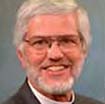Should the preacher of any given Sunday in a lectionary-using congregation focus his or her work on just one of the three texts, doing such serious exegesis as is possible and then bringing that text to expression in the present Sunday assembly? Or should she or he somehow try to take seriously within one sermon all of the texts assigned for the day?
The question leads to more than one answer. If the purpose of preaching is to so proclaim the law and the gospel of God — so proclaim our awful need and so offer freely God’s amazing grace in Christ — that the people of the assembly begin to trust God with their lives again — come to faith again — then that task can be done faithfully with one text or with many. The point is that the preacher preach Jesus Christ, crucified and risen for the life of the world. The Sunday sermon is not an exegetical lecture. Not on one text and not on three. It is the “Today!” of God’s mercy, in the terms of the biblical word.
Perhaps, however, given the awesome difficulty of many biblical texts and the need to clear away so much misconstrued biblical language, one text is quite enough. To take that one text seriously in context, to work with its original language, to embrace its paradoxes and problems, to shake off the paralyzing literalism in which North American culture has so often imprisoned the biblical word, and then to press the text to its deepest intention in expressing our need and God’s grace in Christ — this all seems like plenty of work for any preacher to do.
This answer is the usual counsel of professors of biblical studies and professors of preaching in our seminaries and divinity schools.
But there is another answer as well. Three texts have been read into the room of the assembly when the preacher arises. If they have been read well, they still echo there. One of them–the first one–has often been responded to by the singing of a psalm. And another–the last one–has usually been surrounded with alleluias and with direct address to the Risen Christ. And the whole has been supported by hymns which echo and continue the biblical images. It would seem odd for the preacher to ignore this amazing, rich, layered event. The lectionary texts are designed to stand next to each other, to bring their intentions to clarity in relation to each other. The preacher might take that design seriously, while also doing the serious exegetical work needed for the day.
Indeed, one text next to another — even one text in tension with another — is the way the whole biblical witness has proceeded. Isaiah 43:18 counsels the people not to remember “the former things,” but then all the succeeding new thing is dependent upon a reversal of the images of the salvation worked by God in the Exodus texts. The Markan Jesus promises a mustard-bush as a new tree-of-life (4:30-32), but the parable depends upon the lofty cedar of Ezekiel 17 and other texts. The Lukan Jesus preaches on Isaiah 61, but his sermon also depends upon 1 Kings 17 and 2 Kings 5. And the Risen Jesus on the way to Emmaus preaches on Moses and all the prophets! This is not the hermeneutic of historical-critical studies, but it is the hermeneutic of much of the Bible itself.
The early twentieth century Lutheran theologian, Adolph Köberle, once said, “Here on earth we can never rightly say the truth of God with just one word, but always only with two words” (Rechtfertigung und Heiligung, Leipzig: 1929, 295).
At least two words, maybe three, maybe more.
Perhaps simply the diversity of readings, still echoing in the room, will be the “other words” to the word of a sermon that is focused on just one text. Perhaps the holy supper will be the visible word that balances and is in tension with the sermon as well as the other, uninterpreted texts. But perhaps — at least sometimes or at least in some small ways — the preacher will strive to bring all three texts to expression in the preaching, as images for our need and metaphors for God’s life-giving grace in Christ. In any case, the preacher should certainly do this if one or more of the texts is especially difficult or dangerous were it to remain uninterpreted.
The point is not to preach three short sermons within one preaching-time. The point is rather to preach the law and gospel of God, using the images and intentions of all the texts. On Epiphany 4A, for example, the Matthean Beatitudes are read side by side with the counsel against sacrifice and for humility in Micah 6 and the Pauline word of the cross in 1 Corinthians 1. These texts may, all together, expose our own pride and misuse of religion and give us words to preach Jesus Christ, the persecuted and merciful one. On All Saints Day, however, a text from Revelation 7 stands next to the Beatitudes. The gospel text has a different function. We are invited to see how the peacemaking and meekness of many unknown little ones even still cries out in praise and witness to the Lamb.
In the space between the ancient carved images of the cherubim, Israel was to meet God at the “mercy seat” (Exodus 25:22). In the space between the verbal images of the readings, the preacher may invite us to meet God and to come again to trust God with our lives.
The sermons of Luke 4 and Luke 24 are often rightly considered models of Christian preaching. It is fascinating that both of them stand upon more than one text.

